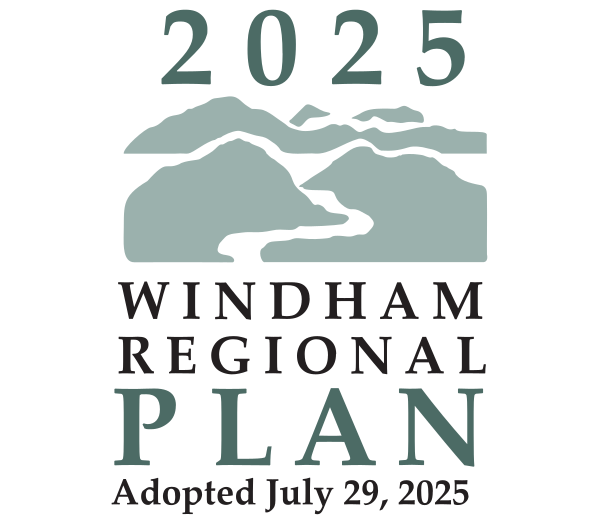LAND USE
The focus of the regional land use plan is to encourage and support development that maintains the region’s historic settlement pattern of compact villages and town centers separated by rural countryside and forests, consistent with state land use law. The regional land use plan includes a Future Land Use Map and description of designated areas that creates a framework for decisions related to growth, development, and conservation throughout the region. The Land Use Management Techniques section of the plan provides specific tools and strategies for municipalities to consider when implementing regional land use policies at the local level.
Background
Looking forward, there are a number of challenges the Windham Region faces as it works to accomplish its land use goals. These include providing necessary public infrastructure to support compact development patterns and creating conditions for housing that is affordable across income levels and different periods of life, responding to the impacts of climate change and increased flood risks, rising public infrastructure costs, protecting limited productive forest and agricultural lands, and changes in demographics, technology, and the local economy.
Vermont’s traditional development model and statutory land use planning goal of compact centers surrounded by countryside has allowed for an efficient use of roads and infrastructure, protected working landscapes and critical natural resource areas, and contributed to a greater sense of community. To maintain this land use pattern, most of the region’s future growth and development will need to occur within or near existing population centers. However, many of the region’s villages have limited or no infrastructure to support this future residential and commercial growth. One of the biggest constraints to growth and higher densities in existing centers is the lack of adequate public water and wastewater systems. This also puts the retention of existing uses at risk as ageing septic systems will be difficult and expensive to replace and expansion of capacity will likely be impossible. Other public infrastructure and amenities, including sidewalks, streetscaping, public spaces, and a mix of commercial and civic uses, are also needed.
Directing growth to our existing centers will help the region become more resilient in the face of climate change. A spread-out development pattern leads to an increased use of vehicles by residents to get to work and access goods and services, increased energy use for heating and cooling buildings, and results in a loss of natural habitats that provide carbon sequestration benefits. In contrast, compact settlements allow for less driving, encourage smaller building footprints with less energy needs, and conserve the region’s natural landscapes. As we encourage growth in these areas, we also need to consider how and where it occurs given the flood and fluvial erosion hazards. Many of the region’s settlements are located adjacent to streams and rivers and are prone to flooding. The region is expected to see an increase in extreme rain events as the climate changes and this will increase the risk of structures and critical infrastructure being damaged or destroyed from flooding.
Municipalities are facing increased costs to maintain existing and invest in new infrastructure. Encouraging compact development that takes advantage of our existing social and civic community centers and their infrastructure supports economic resiliency for towns. Low-density development away from existing centers can result in the eventual expansion of costly public infrastructure, which adds to a municipality’s long- term capital needs for maintenance and replacement.
Historically, the region’s economy was centered around manufacturing and industrial activities in villages and downtowns, and agricultural and forestry industries in rural areas. Over the years, the economy has shifted more towards service-based industries like retail, food services, healthcare, and hospitality. This has implications for how land in the region is being used to support economic activity. With the expanded availability of broadband, the region has seen an increase in the number of remote workers, many whom have chosen to relocate here because of the quality of life it offers. Land use policies will need to be adapted to support existing legacy businesses and entrepreneurial growth, invest in public infrastructure and broadband, and strengthen town centers.
Forest and agricultural lands help define the character and history of the region and provide economic activity while also providing ecosystem services such as habitat, carbon sequestration, and stormwater and flood mitigation. Trends toward forest parcel subdivision and residential and recreational development continue to threaten timber production, hunting and fishing, outdoor recreation, and wildlife habitat and migration corridors. Over the last several decades, there has been a decrease in the number of total acres farmed in the region. However, we have been able to retain and grow a diversity of small-scale agricultural businesses supported by direct market opportunities. For both forest and agricultural industries, it is imperative to maintain an adequate amount of land in these uses to support these activities going forward.
As the composition of the population changes, the region will need to ensure land use policies are responding to the needs of current and future residents. Our population is ageing and it will be critical to provide diverse housing options and services in areas that are affordable and walkable for elderly residents. Local employers are also struggling to maintain and grow their workforce because of a lack of housing for workers. While many new residents are drawn to Vermont because of the rural lifestyle it offers, there are also those that prefer having a smaller footprint home and not having to drive to work or for shopping – opportunities that can be cultivated in our village and town centers. Finally, the region has welcomed refugees and asylum seekers in recent years and we will need to provide welcoming and inclusive communities that offer job opportunities, support services, and childcare that meet the needs of these new residents.
